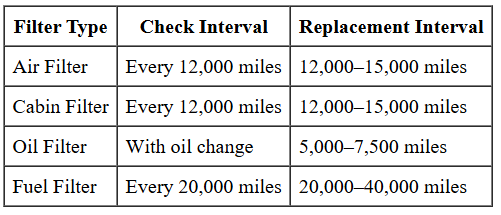
How to Check Car Filters?
There are four key filters in a vehicle: the engine air filter, the engine oil filter, the cabin air filter, and the fuel filter.August 11, 2025
Keeping your car in peak condition doesn't always require a mechanic. One of the most overlooked yet essential aspects of car maintenance is checking the various filters that keep your vehicle running smoothly. Understanding how to check car filters can save you money, extend your car’s lifespan, and even improve performance. This guide breaks it down simply for you.
Understand the Basics: What Are the Main Car Filters and Why Do They Matter?
There are four key filters in a vehicle: the engine air filter, the engine oil filter, the cabin air filter, and the fuel filter. Each one serves a distinct function but shares a common goal—protecting your engine and passengers from harmful particles.
- Air Filter: The air filter stops dirt and debris from getting into your engine.
- Engine Oil Filter: Removes contaminants from engine oil, ensuring lubrication and cooling.
- Cabin Filter: Traps dust, pollen, and pollutants, providing clean air inside the vehicle.
- Fuel Filter: Keeps contaminants in fuel from reaching the engine.
Not taking care of these filters can lead to worse gas mileage, higher emissions, engine damage, or an unpleasant driving experience. That’s why car filter maintenance is crucial.
Step-by-Step Guide: How to Check Car Filters at Home Like a Pro
Before diving in, gather a few basic tools: gloves, a screwdriver set, a flashlight, and possibly your owner’s manual.
Here’s a simple car filter check guide:
- Turn off your engine and make sure the car has cooled down.
- Consult the manual to locate each filter.
- Inspect one filter at a time, noting its cleanliness, color, and presence of debris.
- If you see that it's extremely dirty or blocked, you should think about replacing it.
No need for advanced tools—just a careful eye and a bit of time.
How to Check Air Filter in Car: Signs It Needs Replacement
The air filter is typically housed in a rectangular box under the hood, near the front of the engine.
- How to check air filter in car:
- Open the air filter housing.
- Remove the filter and hold it up to the light.
- If you can't see light through it or it looks dark and dusty, it's time to replace it.
A clogged car air filter can reduce fuel efficiency and performance. Experts advise inspecting it every 12,000 to 15,000 miles; however, if you drive in dusty areas, you should do it more often.
How to Check Oil Filters Without a Mechanic
When it comes to the oil filter, the inspection can be trickier, but not impossible.
- How to check oil filter:
- While you can't easily "see inside" an oil filter, you can monitor oil color on the dipstick.
- If the oil is dark and gritty, it might be time to replace both the oil and the filter.
- Check your car's maintenance log to see when the oil filter was last changed.
Generally, oil filters should be replaced every time you change the oil—around every 5,000 to 7,500 miles for most vehicles.
How to Check Cabin Air Filter for a Fresher Drive
The cabin filter plays a vital role in keeping your car’s interior air clean. A dirty cabin filter can cause musty smells, reduced airflow, and increased allergy symptoms.
- How to check cabin air filter:
- Locate it; usually behind the glovebox or under the dashboard.
- Open the filter compartment and remove the filter.
- If it's grey, dusty, or packed with leaves and debris, replace it.
For optimal air quality, inspect it every 12,000 miles or once a year. Following this habit ensures a fresher drive and better HVAC performance.
When and Why You Should Inspect Your Fuel Filter
A fuel filter is critical for engine health. The filter catches dirt and rust before they get to the engine through the fuel line. If it gets clogged over time, it can cause poor performance or even make your car stall.
How to check car filters like the fuel filter requires caution:
- Listen for hesitation or sputtering during acceleration. These are common signs of a blocked fuel filter.
- You might need to consult a mechanic to visually inspect or replace it, as it's often located near the fuel tank or along the fuel line.
Regular checks every 20,000 to 40,000 miles—or according to the manufacturer—are essential for preventing serious engine problems.
Top Car Filter Maintenance Tips to Keep Your Engine Running Smooth
Here are some practical tips for car filter maintenance:
- Always follow your owner’s manual for replacement intervals.
- Inspect filters during oil changes—two birds, one stone.
- Use original equipment manufacturer (OEM) quality filters to ensure proper fit and filtration.
- Clean your filters only if they are designed to be reusable (like some performance air filters). Store spare filters in a clean, dry space.
These car filter inspection tips will help you avoid costly repairs and keep your engine in top shape.
DIY vs. Mechanic: Who Should Check Your Car Filters and When?
While this guide teaches you how to check car filters at home, some situations are better handled by professionals.
- DIY is ideal for checking air and cabin filters.
- Oil and fuel filter checks often require lifts, special tools, or draining fluids—better left to a mechanic.
Still, knowing how to spot early signs of wear empowers you to act before problems arise.
How Often Should You Check or Change Your Car Filters?
Here’s a general rule of thumb:

Always check your vehicle’s manual for specifics, as intervals vary by make and model.
Signs Your Car Filters Are Hurting Performance
Not sure if your filters need checking? Watch for these signs:
- Engine misfires or sluggish acceleration
- Poor gas mileage
- Musty or stale cabin air
- Unusual engine noises
- Dashboard warning lights
If you notice any of these, follow this car filter check guide or consult a professional right away.


